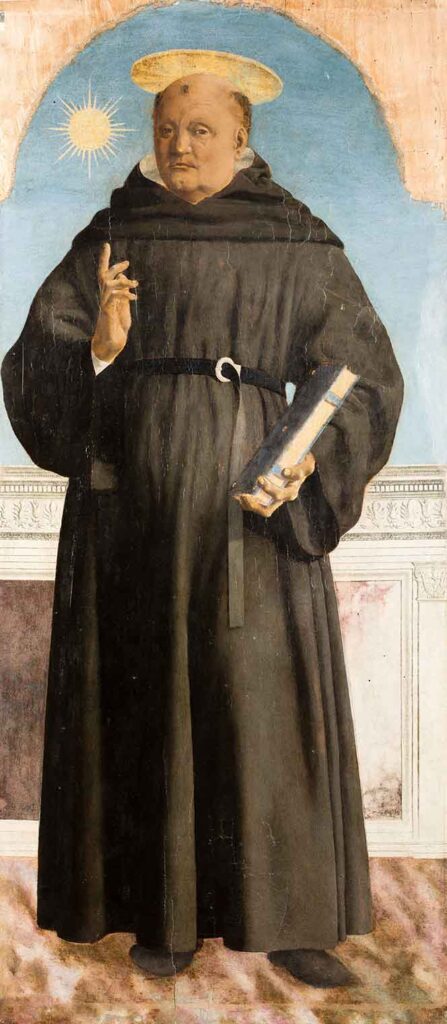Saint Nicholas of Tolentino
Piero della Francesca , 1454 - 1469
Description

The panel was part of a polyptych painted by Piero della Francesca between 1454 and 1469 for the high altar of the church of Sant’Agostino in Borgo San Sepolcro. When Piero set to work, Nicholas was the most recent of the Augustinian saints: although long venerated the 13th century friar had been canonized only in 1446.
The monumental figure of this saint, who knew the pleasures of the table, stands in a severe and hieratic pose against a blue sky and a classical-inspired marble balustrade. Nicholas wears the habit of his order, the Augustinian Hermits – a black hooded habit tied with a buckled belt over a white undergarment – mirroring the appearance of the friars who used to gather in the church in front of Piero’s polyptych. While adhering closely to the depiction of the habit, Piero took liberties in imagining the saint’s face and attributes, including the position of the star that, according to legend, appeared to Nicholas to indicate where he would be buried.
The portrait-like quality of the massive figure reflects the artist’s drawing process, documented in his treatise on perspective, De prospectiva pingendi. The rigorous mathematical method that the painter had theorized for foreshortening the figures in space is evident in the halo, transformed into a solid golden disk perfectly perpendicular to the inclination of the saint’s head.
This polyptych, among the master’s most important works, was unfortunately dismembered and dispersed probably as early as the 16th century. The other surviving panels are now in various European and American museums: Saint Augustine at the Museu Nacional de Arte Antiga in Lisbon; Saint Michael the Archangel at the National Gallery in London; and Saint John the Evangelist at the Frick Collection in New York. In the Frick Collection there are also the Crucifixion from the predella and Saint Monica and Saint Leonard, decorating the piers of the polyptych, as did Saint Apollonia now in the National Gallery, in Washington. The central panel, possibly depicting the Coronation of the Virgin, is now lost.
Data Sheet
Author
Piero della Francesca, 1415-1420/1492
Date
1454 - 1469
Material and technique
Oil on panel
Measures
139.4 cm x 59.2 cm
Acquisition
Gian Giacomo Poldi Pezzoli bequest, 1879
Inventory number
0445
location
Golden Room
The Golden Room is the most important room in the Museum and houses the masterpieces of painting from the Poldi Pezzoli collection. Conceived according to the dictates of the Renaissance style, it was designed to be the hall of honor of Gian Giacomo’s apartment. After the collector’s death, Giuseppe Bertini carried on the work: unfortunately, both the gilded coffered ceiling, the frescoes, painted by Bertini himself, and the damask fabric decorations that lined the walls were destroyed by bombing. The current museographic arrangement dates back to the 1990s. Among the works on display are the Portrait of a Lady attributed to Piero del Pollaiolo and which has become a symbol of the museum, Bellini’s Imago Pietatis, Botticelli’s Lamentation over the Dead Christ, Mantegna’s Madonna and Child, and Piero della Francesca’s Saint Nicholas of Tolentino. The display case separating the Salone Dorato from the Sala degli Stucchi houses the porcelain and majolica collections.
collection
Paintings
The Museum hosts over 300 paintings. Among them, many Italian works from the Renaissance: masterpieces from Tuscany (Botticelli, Piero della Francesca, Pollaiuolo), Lombardy (Luini, Boltraffio, Solario) and Veneto (Bellini, Mantegna). Important is also the group of 18th century Italian painting (Guardi, Canaletto, Tiepolo, Fra Galgario). In the collection, there are mainly portraits and small size paintings.
